- Arabic
- French
- Russian
- Spanish
- Portuguese
- Turkish
- Armenian
- English
- Albanian
- Amharic
- Azerbaijani
- Basque
- Belarusian
- Bengali
- Bosnian
- Bulgarian
- Catalan
- Cebuano
- Corsican
- Croatian
- Czech
- Danish
- Dutch
- Afrikaans
- Esperanto
- Estonian
- Finnish
- Frisian
- Galician
- Georgian
- German
- Greek
- Gujarati
- Haitian Creole
- hausa
- hawaiian
- Hebrew
- Hindi
- Miao
- Hungarian
- Icelandic
- igbo
- Indonesian
- irish
- Italian
- Japanese
- Javanese
- Kannada
- kazakh
- Khmer
- Rwandese
- Korean
- Kurdish
- Kyrgyz
- Lao
- Latin
- Latvian
- Lithuanian
- Luxembourgish
- Macedonian
- Malgashi
- Malay
- Malayalam
- Maltese
- Maori
- Marathi
- Mongolian
- Myanmar
- Nepali
- Norwegian
- Norwegian
- Occitan
- Pashto
- Persian
- Polish
- Punjabi
- Romanian
- Samoan
- Scottish Gaelic
- Serbian
- Sesotho
- Shona
- Sindhi
- Sinhala
- Slovak
- Slovenian
- Somali
- Sundanese
- Swahili
- Swedish
- Tagalog
- Tajik
- Tamil
- Tatar
- Telugu
- Thai
- Turkmen
- Ukrainian
- Urdu
- Uighur
- Uzbek
- Vietnamese
- Welsh
- Bantu
- Yiddish
- Yoruba
- Zulu
Nov . 20, 2024 00:54 Back to list
rubber timing belt
Understanding the Importance of Rubber Timing Belts in Automobile Maintenance
In the world of automotive engineering, a timing belt is a critical component that plays a vital role in the functioning of an internal combustion engine. Particularly, rubber timing belts have become the industry standard due to their effectiveness and durability. The purpose of the timing belt is to synchronize the rotation of the crankshaft and camshaft, ensuring that the engine’s valves open and close at the proper times during each cylinder's intake and exhaust strokes. This synchronization is crucial for the smooth operation of the engine.
Rubber timing belts are typically made from high-quality synthetic rubber, reinforced with fibers like fiberglass or carbon
. This composition allows them to withstand high temperatures, pressure, and the constant motion and stress encountered during operation. Additionally, modern rubber timing belts incorporate advanced materials that contribute to their longevity, making them a reliable choice for vehicle engines.One of the primary advantages of rubber timing belts is their ability to run quietly and efficiently. Unlike chains, which can rattle and create noise over time, rubber belts operate smoothly, contributing to a quieter engine performance. Moreover, the lightweight nature of rubber timing belts reduces the overall weight of the engine, thereby enhancing fuel efficiency. This characteristic is particularly appealing in today’s automotive market, where manufacturers are increasingly focused on sustainability and reducing carbon footprints.
rubber timing belt

However, like all components of a vehicle, timing belts do not last indefinitely. Most manufacturers recommend replacing the timing belt every 60,000 to 100,000 miles, depending on the vehicle make and model. Regular inspections are also crucial; even if a belt appears to be in good condition, it can develop cracks, dry rot, or other forms of wear that could lead to catastrophic failure. A snapped timing belt can lead to severe engine damage, possibly resulting in costly repairs that could have been avoided with proper maintenance.
When it comes to replacement, it is advisable to use belts from reputable manufacturers or original equipment (OE) parts to ensure compatibility and reliability. Additionally, many technicians recommend replacing the water pump, tensioner, and other related components simultaneously, as these parts often wear out around the same time as the belt itself. This preventative measure can save both time and money in the long run.
Another important consideration regarding rubber timing belts is the environmental aspect. The disposal of old belts must be done responsibly, adhering to local automotive waste regulations. As the industry shifts towards more sustainable practices, research is ongoing to develop biodegradable or recyclable materials for automotive components, including timing belts.
In conclusion, rubber timing belts are an essential component of modern automotive engines, enabling efficient, reliable performance. Their importance cannot be overstated, as they play a key role in maintaining the functional integrity of the engine. By adhering to recommended maintenance schedules, utilizing high-quality replacement parts, and considering the environmental impact, vehicle owners can ensure their engines run smoothly for years to come. Proper understanding and management of timing belt maintenance can significantly extend the life of a vehicle and prevent costly repairs, ultimately leading to a more enjoyable driving experience.
-
Buy Serpentine Belt Online – Affordable Prices & Durable Quality
NewsJul.26,2025
-
High-Performance Metric Variable Speed Belts for Industrial Use
NewsJul.25,2025
-
High-Quality Endless Flat Drive Belt for Precision Power Transmission
NewsJul.24,2025
-
High-Performance Serpentine Belt for Car Engines – Durable & Reliable
NewsJul.23,2025
-
High Efficiency V Belt Drive with Double & Toothed Options for Industry
NewsJul.22,2025
-
Affordable Fan Belt Cost - Compare Prices & Save | Auto Parts Deals
NewsJul.22,2025

